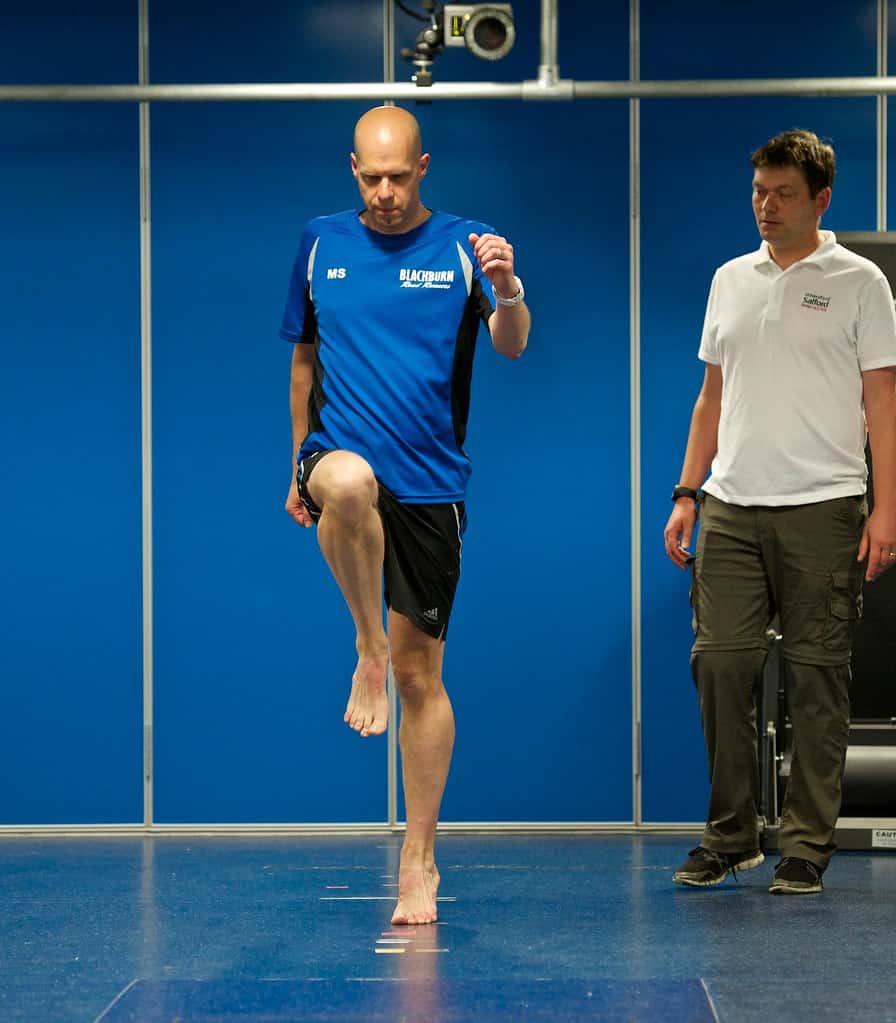Contents
The hip is another ball and socket joint, but has reduced levels of movement compared to the shoulder. The joint’s main role is weight bearing.
Inspection
Ask the patient if they have any hip pain! When do they get it? Where is it?
Ask if they are able to stand
Look at:
- Symmetry of hips
- Height of hips
- Any obvious leg length discrepancy
- Look for muscle wasting:
- Gluteal
- Quadriceps
- Make sure you look from the front, back and sides for wasting, deformity and scars. Feel the temperature.
Examine Gait
- Antalgic gait – often indicative of arthritis, although can be secondary to pain anywhere in the leg.. The patient spends as little time as possible bearing weight of the affected leg. There is a fast leg swing on the contralateral leg. Patient leans towards the affected side to minimise movement of the hip.
- Trendelenburg gait –caused by weakness of the abductor muscles of the lower limb (gluteus medius, gluteus minimus).This tends to be the result of chronic hip disease. The patient is unable to maintain hip stability, and the hip drops on the affected side. To compensate, the patient will lean away from the affected side, to try and raise the hip. The pelvis on the unaffected side will drop when they stand on the affected leg – this is known as the Trendelenberg Sign.
- Trendelenberg test – hold the patients hands in front of them ask them to stand on one leg at a time. Check that the hip rises on the leg that is off the floor. If it falls, and/or the patient becomes unstable, this shows abductor weakness in the weight bearing leg.
Ask the patient to lay on the couch, and try to expose the hip as much as possible (e.g. strip down to underwear). Make sure that the bed is flat!Look for any signs of:
- Deformity
- Scars
- Wasting
- Start feeling at the ASIS (anterior superioir iliac spine), make sure you feel over the trochaneteric bursa for bursitis.
Measure leg length
- True leg length – make sure the legs are in the same posture. measure from the anterior superior iliac spine to the medial malleous of the same side. Normal measurements should be within 1cm of each other. If the patient appears to walk with one leg shorter than the other, but true leg length is normal, there may be a problem with the pelvis, or the spine. You should measure:
- Apparent leg length –measure from the umbilicus to the medial malleoulus, with the legs relaxed! – i.e. if there is a flexion deformity, this will alter the ‘apparent leg length’, but not the true leg length. Repeat for both legs. This takes into account the hip joint. A difference of >2cm is significant.
Palpation
Feel around the hip joint for tenderness. Particular areas to pay attention to the Greater Trochanter
- Bursitis – common cause of pain in this region
- Also the insertion of many muscles
Movement
Get the patient to lie flat on the couch. Here you can test all movements of the hip, except extension. Ask the patient to do active movements before passive.
- Hip flexion – flex the hip with the knee bent. You should be able to get to 120’.
- Hip abduction – Stabilise the patient’s pelvis by your hand on the contralateral ilium. Make sure the patient does not rotate the hip by holding the ankle. Once the contralateral hip starts to deviate, this is the point of maximum abduction. This is usually about 45’.
- Hip adduction – Same as above, however the maximum degree of adduction is only about 30’, and you press on the ipsilateral hip!
- Internal Rotation – Flex the knee to 90’, and rotate the foot laterally. You should be able to go to 45’. This is one of the earliest signs to elicit pain in hip disease
- External Rotation – Same as above, except rotate the foot medially
- Extension of the hip – Ask the patient to lie on their front (prone). Ask them to actively extend the hip.
- For all these movements, note any discrepancy between active and passive movement. Normally both active and passive should be equal. If active movements are limited, ask the patient if this is because of pain or reduced ability to move the joint
Thomas’s test
Assesses for fixed flexion hip deformity. Which can occur as a result of osteoarthritis.
Ask the patient to lie flat on their back. Ask the patient to flex the opposite hip to the one being tested. It is easiest if the patient bends their knee, and then flexes the opposite leg as far as possible. In a normal individual, the leg being assessed, will stay flat on the table. In fixed flexion deformity, there may be a slight raise of the leg, as the opposite one is flexed.
You should put your left hand under the patient’s lumbar spine. In a normal individual, you will feel the lumbar lordosis flatten out as the leg is raised, and the spine will press against your hand.
You should put your left hand under the patient’s lumbar spine. In a normal individual, you will feel the lumbar lordosis flatten out as the leg is raised, and the spine will press against your hand.
